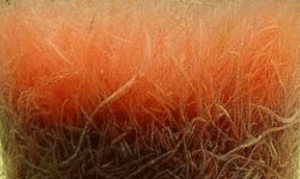Threadworms or red worms are a phenomenon that can be encountered in the Aerobic tank in the Wastewater Treatment System.
Characteristics of identifying worms in aerobic tanks and harmful effects
- Threadworms or red worms often appear in many round, red pea-sized masses mixed in the mud
- Thrives in wastewater treatment systems with oxygen levels above 2mg/L.
- They will “eat” the biomass to grow and cause TSS problems
- Loss the ability of the aerobic tank to remove ammonium.

How to handle threadworms in aerobic tanks
- Increase BOD load, reduce sludge rate:
- The growth of worms indicates that the F/M ratio is too low for a long time or the tank has too much sludge (high MLSS), low average DO.
- => They will grow and eat the mud floss in our aerobic tank.
- Therefore, we need to provide more nutrients (BOD) or reduce sludge ratio (MLSS) to get sludge flocs or add probiotics to increase the amount of missing microorganisms.
- Release fish to eat these worms:
- These worms will be a nutritious food source for many types of fish, so releasing fish to let them eat these worms is also a good solution.
- You can put carp, perch, etc. so that they can grow well in the aerobic tank.
- Remember to put a filter net to limit these types of fish from swimming out!
- Using chlorine to disinfect:
- When too many worms appear, the final solution is to use chlorine to kill these worms.
- Using chlorine can kill these worms along with microorganisms, so we will spend time re-rearing the microorganisms after you use chlorine to kill worms.
- The amount of chlorine will be guaranteed according to calculations for each different system.
Please contact us for support, to share issues related to wastewater treatment, treatment system operation,… or other related issues.


Bài viết liên quan
UASB tank in wastewater treatment
Introducing the UASB tank UASB stands for Upflow Anaerobic Sludge Blanket, roughly translated as reverse...
Wastewater treatment of carton paper packaging production
Origin of wastewater from carton packaging production Wastewater containing printing ink generated during the production...
Common Aerotank tank problems and how to fix them
Aerotank incidents during the operation of the WWTP often arise equipment problems such as pumps,...